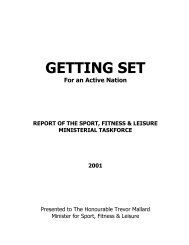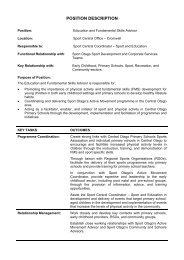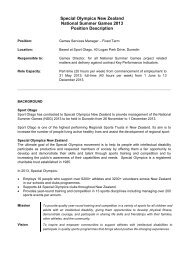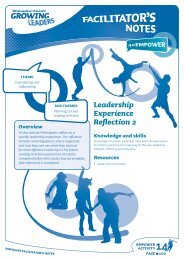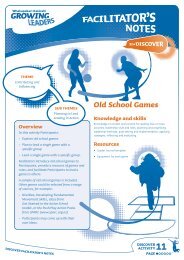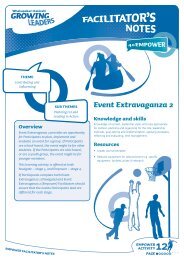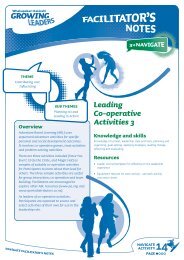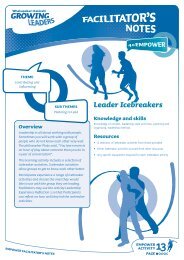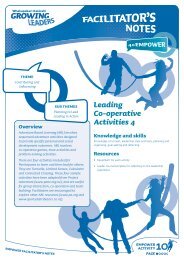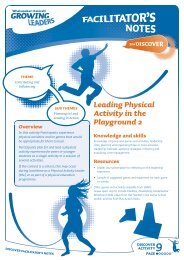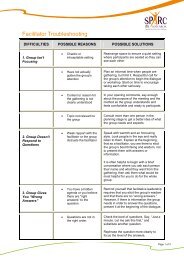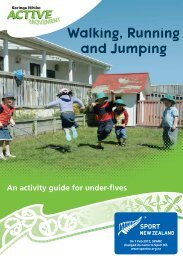Craig Tiley - player and coach development (PDF, 414 Kb)
Craig Tiley - player and coach development (PDF, 414 Kb)
Craig Tiley - player and coach development (PDF, 414 Kb)
Create successful ePaper yourself
Turn your PDF publications into a flip-book with our unique Google optimized e-Paper software.
Player <strong>and</strong> Coach Development<br />
“Refocusing to Win”
Re-igniting a Tennis Nation…….<br />
The Action Plan<br />
I. Identify the Issues<br />
II. Define the Development Principles<br />
III. Develop the Strategy<br />
IV. Drive the Change<br />
“We don’t need a message of action but a message of persistent<br />
<strong>and</strong> additional action”
I. Identify the Issues
Australian Tennis in Crisis – The Decline<br />
1. A 15 year decline of Australian <strong>player</strong>s ranked inside the top 500 on the<br />
professional tours<br />
2. The average age of ranked Australian <strong>player</strong>s in the top 500 is well<br />
above the international average<br />
3. The last Australian <strong>player</strong> to win out of his/her age group did so ten<br />
years ago<br />
4. No Australian <strong>player</strong> has transitioned into the top 100 within 12 – 18<br />
months after juniors, since Lleyton Hewitt<br />
5. No junior <strong>player</strong>s have been clearly dominant internationally for the<br />
past 15 years
6. Australia has consistently shown the weakest transition from juniors to the<br />
professional rankings compared to other tennis nations<br />
Countries<br />
Australia France Spain USA Russia Czech Engl<strong>and</strong> China Argentina Brazil<br />
Population (November 2005) 20.1 Million 60.7 Million 40.3 Million 296 Million 143.1 Million 10.2 Million 60.4 Million 1.30 Billion 39.6 Million 186.8 Million<br />
Boys (B) / Girls (G) B G B G B G B G B G B G B G B G B G B G<br />
ITF 150 10 5 3 2 1 0 21 20 4 22 8 8 2 2 2 3 3 1 5 3<br />
ITF 300 19 10 9 3 2 0 30 34 12 33 8 11 8 8 3 4 5 1 8 5<br />
ITF 400 - 16's 9 8 2 2 0 0 9 10 3 19 3 6 2 4 0 2 0 0 0 2<br />
ITF 600 - 16's 9 9 2 3 0 0 12 14 7 21 4 7 3 6 0 2 0 0 0 3<br />
ITF Ranked - 15 (total) 8 14 7 9 3 4 14 25 15 34 3 15 2 13 3 2 1 2 0 3<br />
ITF Ranked Players (total) 66 68 40 44 33 20 129 167 81 125 40 24 59 62 13 8 39 32 60 39<br />
Male(M) / Female (F) M W M W M W M W M W M W M W M W M W M W<br />
ATP/WTA 100 2 2 9 8 12 6 8 10 5 14 8 6 3 0 0 3 10 2 0 0<br />
ATP/WTA 200 5 4 21 13 20 9 17 23 7 20 10 15 4 1 2 7 15 5 7 1<br />
ATP/WTA 350 10 8 28 17 31 12 31 36 9 29 16 23 12 5 3 10 27 10 11 4<br />
ATP/WTA 500 15 17 36 31 42 20 42 46 12 37 24 29 19 11 3 11 34 14 16 5
Flawed Strategy<br />
1. Excessive governance <strong>and</strong> administration requirements in high<br />
performance<br />
2. Lack of accountability <strong>and</strong> responsibility of athletes <strong>and</strong> <strong>coach</strong>es<br />
3. Athletes allowed to dictate training loads <strong>and</strong> support – Athlete driven<br />
programs<br />
4. Lack of national curriculum for skill <strong>development</strong>, tactics <strong>and</strong> physical<br />
training.<br />
5. Lack of a holistic view by parents, <strong>coach</strong>es <strong>and</strong> athletes<br />
6. No ability to directly influence the st<strong>and</strong>ard of <strong>coach</strong>ing<br />
7. Insufficient funds to drive change <strong>and</strong> implement national programs<br />
8. Uncoordinated national pathway with no clearly defined entry <strong>and</strong> exit<br />
points
II. Define the Development Principles
1. Coach Driven versus Athlete Driven Programs<br />
2. A national athlete <strong>and</strong> <strong>coach</strong> pathway with clearly defined entry<br />
<strong>and</strong> exit points<br />
3. Recognition of national <strong>and</strong> international competition<br />
4. A coordinated national program with a focus on long term<br />
athlete <strong>development</strong><br />
5. Draw on past successes – Collective training environments<br />
6. Clearly defined systems of athlete, <strong>coach</strong> <strong>and</strong> parent<br />
accountability<br />
7. Integration of sport science <strong>and</strong> available resources
8. Defining a sport specific <strong>player</strong> <strong>development</strong> model<br />
Execution<br />
Biomechanics<br />
<strong>and</strong><br />
Technique<br />
Decision<br />
Making<br />
Mental<br />
Awareness<br />
Scheduling<br />
Tactics –<br />
Doubles,<br />
Singles<br />
Physical<br />
Speed <strong>and</strong> Agility<br />
Cardiovascular<br />
Endurance<br />
Strength <strong>and</strong> Power<br />
Flexibility<br />
Speed/Agility<br />
Endurance<br />
Nutrition<br />
Hydration
9. Coaching Generation Y versus Generation X <strong>and</strong> knowing future trends<br />
Influence<br />
Baby Boomer Generation X Generation Y<br />
Role Model<br />
Men of character<br />
Men <strong>and</strong> women of<br />
character<br />
What is character?<br />
Respecting Elders<br />
Automatic<br />
Is polite<br />
Whatever?<br />
Money<br />
Earn it<br />
It is not everything<br />
Give it to me<br />
Loyalty<br />
Work my way to the<br />
top<br />
Shortcut to the top<br />
Give me Saturday off<br />
or I will quit<br />
Change<br />
Resist it<br />
Accept it<br />
Want it<br />
Decision Making<br />
Calculated<br />
Based on research<br />
Based on advice of<br />
friends<br />
Learning<br />
Important<br />
Want structure<br />
Want freedom <strong>and</strong><br />
experiences<br />
Technology<br />
Ignorant of it<br />
Comfortable<br />
Feel it in their gut<br />
Gen Y – “They don’t care how much you know until they<br />
know how much you care.” – Peter Sheahan
10. Incorporate components of Athletic Success<br />
(as ranked in a recent survey of over 300 Olympic medallists)<br />
• Dedication <strong>and</strong> Persistence<br />
• Family <strong>and</strong> Friends<br />
• Coaches<br />
• Love of the Sport – Passion<br />
• Training program <strong>and</strong> Facilities<br />
• Natural talent<br />
• Competitiveness<br />
• Focus<br />
• Work Ethic<br />
• Financial Support
III. Develop the Strategy
Planning Pyramid<br />
Mission<br />
Strategic<br />
Plan<br />
Vision<br />
Core Values<br />
Strategic Priorities<br />
Stable<br />
Foundation<br />
Goals <strong>and</strong> Objectives<br />
Key Performance Objectives<br />
Action Plan<br />
Key Performance Indicators<br />
Business<br />
Unit<br />
Operating<br />
Plans<br />
Rewards <strong>and</strong> Recognition
IV. Drive the Change
Coach Development<br />
Strategic Priority #1: Deliver a successful national <strong>coach</strong>ing program<br />
Objectives:<br />
a. Conduct junior <strong>development</strong>, club professional <strong>and</strong> high performance <strong>coach</strong>ing courses<br />
b. Grow <strong>coach</strong> membership<br />
c. Deliver professional <strong>development</strong> programs for <strong>coach</strong>es including national<br />
conferences, online education <strong>and</strong> workshop series<br />
d. Produce world class <strong>coach</strong>ing resources<br />
Strategic Priority #2: Enhance the opportunities <strong>and</strong> well-being of athletes<br />
<strong>and</strong> parents<br />
Objectives:<br />
a. Provide parent education<br />
b. Develop direct <strong>and</strong> online athlete education opportunities
Athlete Development<br />
Strategic Priority #3: Identify <strong>and</strong> provide opportunities for talented athletes<br />
Objectives:<br />
a. Promote <strong>and</strong> grow the National Talent Search program<br />
b. Identify <strong>and</strong> resource Talent Development Coaches<br />
c. Produce Talent Identification resources<br />
d. Link Talent Identification to national programs<br />
Strategic Priority #4: Develop highly focused collective training environments<br />
Objectives:<br />
a. Develop High Performance Academies<br />
b. Increase the number, conversion <strong>and</strong> retention of scholarship holders while maintaining<br />
the highest st<strong>and</strong>ards of behaviour<br />
c. St<strong>and</strong>ardise National High Performance Academy training
Tennis Australia<br />
• Long Term Athlete Development Matrix
Training Pathway
Strategic Priority #5: Integrate sport science <strong>and</strong> medicine to enhance<br />
athlete <strong>and</strong> <strong>coach</strong> <strong>development</strong><br />
Objectives:<br />
a. Develop <strong>and</strong> adhere to all st<strong>and</strong>ardised testing protocols<br />
b. Design <strong>and</strong> implement an all-encompassing national sports medicine program<br />
Strategic Priority #6: Foster successful professional athlete performance<br />
Objectives:<br />
a. Be competitive in World Group in Fed Cup, Davis Cup <strong>and</strong> the Olympic Games<br />
b. Ensure a positive ranking improvement ratio for all athletes in the AIS Pro Tour<br />
Program<br />
c. Set an exemplary st<strong>and</strong>ard of professionalism
Tournaments & Competitions<br />
Strategic Priority #7: Integrate tournaments <strong>and</strong> competitions into a<br />
national framework<br />
Objectives:<br />
a. Align national, state <strong>and</strong> local competition formats<br />
b. Design a user-friendly national calendar<br />
c. Maintain the ongoing <strong>development</strong> of the Australian Ranking system<br />
Strategic Priority #8: Enhance junior tournaments, competitions, tours <strong>and</strong><br />
camps<br />
Objectives:<br />
a. Increase junior competitive <strong>and</strong> Australian Ranking opportunities<br />
b. Advance the consistent delivery of st<strong>and</strong>ardised tours <strong>and</strong> camps
Competitions Pathway
Strategic Priority #9: Maximise the quality <strong>and</strong> quantity of professional<br />
competitive opportunities<br />
Objectives:<br />
a. Design an annual Pro Circuit calendar reflective of our athletes’ objectives<br />
b. Develop resources <strong>and</strong> education for the advancement of Pro Circuits<br />
c. Develop <strong>and</strong> implement a model to increase the number <strong>and</strong> st<strong>and</strong>ard of Australian<br />
Money Tournaments<br />
Strategic Priority #10: Deliver successful events through a commercial<br />
promoter model<br />
Objectives:<br />
a. Identify commercial promoters for Pro Circuit <strong>and</strong> Australian Open Series events<br />
b. Implement venue buy-in <strong>and</strong>/or commercial promoter models for Pro Circuit <strong>and</strong><br />
Australian Open Series events<br />
c. Drive a uniform st<strong>and</strong>ard <strong>and</strong> consistent delivery of Pro Circuit <strong>and</strong> Australian Open<br />
Series events
IN SUMMARY…
Athlete Development<br />
BEFORE<br />
Selection subjective<br />
Programs athlete driven <strong>and</strong> adjusted<br />
to the level of the <strong>player</strong><br />
Parents kept at arms length<br />
Disjointed <strong>and</strong> uncoordinated National<br />
Athlete Pathway<br />
Tennis Players came through via<br />
natural selection<br />
NOW<br />
Selection based on criteria:<br />
-Ranking<br />
-Results<br />
-Participation<br />
Athletes meet the st<strong>and</strong>ards of the<br />
program<br />
Parents educated on their role <strong>and</strong><br />
involvement in their child’s program<br />
National Athlete Pathway with clearly<br />
defined entry <strong>and</strong> exit points<br />
Searching for the Athletes
Tournaments & Competitions<br />
BEFORE<br />
Independent selectors<br />
NOW<br />
National Coaches as selectors<br />
Junior <strong>player</strong>s compete without<br />
parents to teach independence<br />
Consider <strong>and</strong> include parents<br />
Fewer competitive opportunities<br />
16 year-olds to compete in 70-80<br />
competitive matches
Coach Development<br />
BEFORE<br />
Traditional teaching methods<br />
Manual based focus<br />
Exam-based assessment<br />
Touring <strong>coach</strong>es predominantly former<br />
<strong>player</strong>s<br />
Independent modified junior tennis<br />
programs<br />
NOW<br />
Competency based training<br />
framework<br />
On-court practical focus,<br />
Simulated <strong>and</strong> real-work<br />
environments<br />
Ongoing assessment <strong>and</strong><br />
professional <strong>development</strong><br />
Touring <strong>coach</strong>es have completed<br />
formal training <strong>and</strong> High Performance<br />
Coaches Course<br />
Nationally integrated <strong>development</strong><br />
programs such as Hot Shots
“The definition of insanity is doing the<br />
same thing over <strong>and</strong> over again <strong>and</strong><br />
expecting different results”<br />
Albert Einstein



